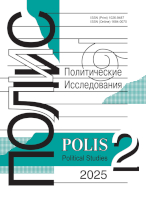Balance of Power Between the G-20 States:
Analysis with Multidimensional Scaling Method
Artyushkin V.F.,
Moscow State Institute of International Relations (MGIMO University), Moscow, Russia, ururur1@bk.ru
elibrary_id: 73848 |
Kazantzev A.A.,
Moscow State Institute of International Relations (MGIMO University); National Research University Higher School of Economics, Moscow, Russia, andrka@mail.ru
elibrary_id: 123521 | ORCID: 0000-0002-4845-1391 | RESEARCHER_ID: H-2728-2016
Sergeev V.M.,
Moscow State Institute of International Relations (MGIMO University), Moscow, Russia, victor04076831@mail.ru
elibrary_id: 1447 |
DOI: 10.17976/jpps/2021.02.09
Artyushkin V.F., Kazantzev A.A., Sergeev V.M. Balance of Power Between the G-20 States: Analysis with Multidimensional Scaling Method. – Polis. Political Studies. 2021. No. 2. https://doi.org/10.17976/jpps/2021.02.09
The article was prepared with the financial support of MGIMO University in the framework of project No. 1921-01-02 “The Chinese project ‘Belt and Road’: the formation of regional structures in Asia and global economic and political changes.
This article applies a method of multidimensional scaling (visualization of multi-dimensional structures) to studying different dimensions of power competition between the great states. On the basis of analysis of the Neo-Realist, Neo-Liberal, and World-systems theory literature on global hegemony, 8 criteria of global leadership were defined: GDP per capita (PPP), military expenditure (% of GDP), amount of currency reserves (including gold), export of goods and services, direct foreign investments, population size in urban agglomerations with more than one million people (% of total population), articles in peer-reviewed scholarly journals, and patent applications. A group of 19 states of the G-20 (excluding the EU) was selected for comparative analysis. Four models visualizing positions of 19 countries according to 8 dimensions were created: for 2004, 2009, 2013, and 2016. These results were compared to the results of calculation including 14 countries: Argentine, Brazil, China, Germany, Spain, France, Great Britain, India, Italy, Japan, Mexico, Russia, Turkey, and the USA. Using mathematical methods of analysis, as traditionally applied in IR literature, turns the making of such models into a very complicated task. Therefore, the mathematical method of the visualization of multi-dimensional structures developed by Russian scholars was applied to this task. The models demonstrate that China’s positions sharply increased in 2009 and since that time China has started to slowly replace USA as an absolute leader. However, if we analyze leadership within specific categories included into our model, the USA still hold leading (or close to leading) positions according to the majority of parameters, while China has a strictly defined profile of leadership connected to its accelerated economic and technical development. However, China is still far from leadership, from the point of view of the development of social structures and even regarding the military dimension.
References
Adelman I., Morris C.T. 1974. The Derivation of Cardinal Scales from Ordinal Data: An Application of Multidimensional Scaling to Measure Levels of National Development. – Economic Development and Planning: Essays in Honour of Jan Tinbergen. Ed by. W. Sellekaerst. London: Macmillan. 428 р.
Arrighi G. 1994. The Long Twentieth Century: Money, Power, and the Origins of Our Times. London: Verso. 416 p.
Arrighi G. 2007. Adam Smith in Beijing: Lineages of the Twenty-First Century. London: Verso. 418 p.
Braudel F. 1967. Civilisation materielle, economie et capitalisme, XVe-XVIIIe siecle. Vol. 3. Le temps du monde. Paris: A. Colin. 637 p.
Gilpin R.G. 1988. The Theory of Hegemonic War. – The Journal of Interdisciplinary History. Vol. 18. No. 4. P. 591-613. https://doi.org/10.2307/204816
Gilpin R.G. 1996. No One Loves Political Realist. – Security Studies. Vol. 5. No. 3. P. 3-26. https://doi.org/10.1080/09636419608429275
Groenen P., Heiser W. 1996. The Tunneling Method for Global Optimization in Multidimensional Scaling. – Psychometrika. Vol. 61. No. 3. P. 529-550. https://doi.org/10.1007/BF02294553
Jacoby W.G., Armstrong D.A. 2014. II Bootstrap Confidence Regions for Multidimensional Scaling Solutions. – American Journal of Political Science. Vol. 58. No. 1. P. 264-278. https://doi.org/10.1111/ajps.12056
Keohane R.O. 1982.The Demand for International Regimes. – International Organization. Vol. 36. No. 2. P. 325-355. https://doi.org/10.1017/S002081830001897X
Keohane R.O. 1984. After Hegemony: Cooperation and Discord in World Political Economy. Princeton: Princeton University Press. 312 p. https://doi.org/10.1515/9781400820269
Kindleberger Ch.P. 1986. Hierarchy versus Inertial Cooperation. – International Organization. Vol. 40. No. 4. P. 841-847. https://doi.org/10.1017/S0020818300027399
Machado J.T. 2010. Identifying Economic Periods and Crises with the Multidimensional Scaling. – Nonlinear Dynamics. Vol. 63. No. 4. P. 611-622. https://doi.org/10.1007/s11071-010-9823-2
Machado J.T., Mata M.E. 2013. Multidimensional Scaling Analysis of the Dynamics of a Country Economy. – The Scientific World Journal. Vol. 97. https://doi.org/10.1155/2013/594587
Machado J.T., Mata M.E. 2015. Analysis of World Economic Variables Using Multidimensional Scaling. – PLoS ONE. Vol. 10. No. 3. https://doi.org/10.1371/journal.pone.0121277
Modelski G. 1987. Long Cycles in World Politics. Palgrave Macmillan. 244 p.
Modelski G. 1996. Evolutionary Paradigm for Global Politics. – International Studies Quarterly. No. 40. P. 321-342. https://doi.org/10.2307/2600714
Sanidas E. 2017. Evidence of the Strong Nexus between Economic, Social, Business, and Political Indicators across the World. – International Journal of Economics & Management Sciences. Vol. 6. No. 6. https://doi.org/10.4172/2162-6359.1000481
Sergeyev V., Belyaev A., Biryukov N., Dranyov Ya., Gleisner J. 1995. Voting in the Russian Parliament (1990-93): The Spectrum of Political Forces and the Conflict between the Executive and the Legislative. – Journal of Behavioral and Social Sciences. No. 2. P. 66-108.
Shapiro J. 2018. What “America First” Will Cost Europe. Could Trump’s Neglect Undo the EU? – Foreign Affairs, 12.06. URL: https://www.foreignaffairs.com/articles/europe/2018-06-12/what-america-first-willcost-europe (accessed 20.09.2019).
Webb M.C., Krasner S.D. 1989. Hegemonic Stability Theory: An Empirical Assessment. – Review of International Studies. Vol. 15. No. 2. P. 193-198. https://doi.org/10.1017/S0260210500112999
Arapova E. 2018. China: Trends of International Interaction amid Contemporary Challenges. – World Economy and International Relations. Vol. 62. No. 6. P. 77-85. (In Russ.) https://doi.org/10.20542/0131-2227-2018-62-6-77-85
Artyushkin V.F. 2007. Regional Conflicts and the Process of Price Formation in the World Oil Market. – Polis. Political Studies. No. 5. P. 129-139. (In Russ.) https://doi.org/10.17976/jpps/2007.05.11
Artyushkin V.F. 2010. Forecasting of an Energy Policy. – Observer. No. 12. P. 72-81. (In Russ.)
Barabanov O.N., Bordachev T.V., Lisovolik Ya.D., Luk’yanov F.A., Sushentsov A.A., Timofeev I.N. 2018. Zhizn’ v osypayushchemsya mire. Doklad mezhdunarodnogo kluba “Valdai” [Living in Crumbling World. Report by International club Valdai]. Moscow. 130 p. (In Russ.) URL: https://ru.valdaiclub.com/files/22596/ (accessed 20.08.2019).
Denisov I.E. 2015. Chinese and Western Values in the Modern Political Discourse of China. – Polis. Political Studies. No. 6. P. 35-44. (In Russ.) https://doi.org/10.17976/jpps/2015.06.06
Lukin A. 2016. Post-Bipolar World: Peaceful Coexistence or Chaos? – World Economy and International Relations. Vol. 60. No. 1. P. 17-29. (In Russ.)
Wallerstein I. 2001. World-Systems Analysis: An Introduction. (Russ. ed.: Wallerstein I. Analiz mirovykh sistem i situatsiya v sovremennom mire. Saint Petersburg: Universitetskaya kniga. 416 p.)
See also:
Zakirova L.I.,
Political aspects of the state of US economy and finance and the US-Russian economic relations by a new electoral cycle. – Polis. Political Studies. 2011. No4
Trubitzyn D.V.,
«Megatrends of world development» or «Modernization»: methodological dilemma. – Polis. Political Studies. 2010. No6
Zagladin N.V.,
Crisis of civilization or of humanitarian knowledge?. – Polis. Political Studies. 2010. No2
Voskressenski A.D.,
World regional studies and the prospects of non-western (sinocized) international relations (IR) theory. – Polis. Political Studies. 2013. No6
Zagladin N.V., Kucherenko A.A.,
Global Crisis: Reasons, Consequences and Russia (Returning to What’s Been Read). – Polis. Political Studies. 2009. No3





.jpg)






 print
print
.jpg)
.jpg)